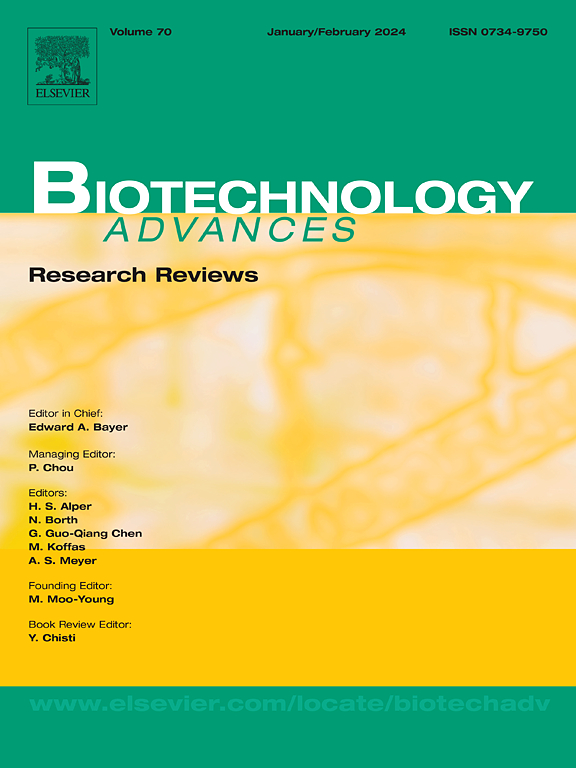Specialized pro-resolving mediators: Biosynthetic pathways, biocatalytic synthesis, and applications
IF 12.5
1区 工程技术
Q1 BIOTECHNOLOGY & APPLIED MICROBIOLOGY
引用次数: 0
Abstract
Specialized pro-resolving mediators (SPMs), a class of di- and trihydroxy fatty acids derived from C20- and C22-polyunsaturated fatty acids, are endogenously produced by human M2 macrophages, polymorphonuclear leukocytes, and other immune and structural cells. They play crucial roles in the resolution of inflammation and infection. Owing to their potent bioactivities, SPMs have attracted considerable interest for applications in food, cosmetics, and clinical therapeutics. Therefore, achieving high concentrations of these mediators is essential. This review provides a comprehensive overview of the nomenclature, classification, biological functions, biosynthetic pathways, and recent advances in the biocatalytic synthesis of SPMs, including lipoxins, resolvins, protectins, and maresins. We examine the biosynthetic pathways: from arachidonic acid to lipoxins; from eicosapentaenoic acid, docosahexaenoic acid, and n-3 docosapentaenoic acid to resolvin E, D, and T series, respectively; and from docosahexaenoic acid to protectins, and maresins. These pathways are catalyzed by fatty acid oxygenases, such as lipoxygenases (LOXs), aspirin-triggered cyclooxygenases, and cytochrome P450 monooxygenases, in combination with hydrolases and peroxidases. Recent advances in microbial biocatalysis, particularly through the use of recombinant cells expressing microbial LOXs, have enabled the efficient synthesis of SPMs. The discovery of microbial double‑oxygenating LOXs has significantly improved production yields, achieving gram-per-liter scale. To further enhance the biocatalytic synthesis, this review discusses enzyme discovery, protein engineering, and biocatalysis optimization strategies aimed at enhancing SPM production. Notably, computational and artificial intelligence-driven approaches are emerging as powerful tools for the discovery and engineering of high-efficiency LOXs, providing a promising route to improve the biocatalytic synthesis of SPMs.
专门的促分解介质:生物合成途径,生物催化合成及其应用。
专门的促分解介质(SPMs),二羟基和三羟基脂肪酸来源于C20-和c22多不饱和脂肪酸,是由人M2巨噬细胞、多形核白细胞和其他免疫和结构细胞内源性产生的。它们在解决炎症和感染中起着至关重要的作用。由于其强大的生物活性,SPMs在食品、化妆品和临床治疗方面的应用引起了人们的极大兴趣。因此,实现这些介质的高浓度是必不可少的。本文综述了油脂类物质的命名、分类、生物学功能、生物合成途径以及生物催化合成的最新进展,包括脂毒素、溶解蛋白、保护蛋白和脂毒素。我们研究了生物合成途径:从花生四烯酸到脂毒素;由二十碳五烯酸、二十二碳六烯酸和n-3二十二碳五烯酸分别分解为E、D、T系列;从二十二碳六烯酸到保护剂和黄油。这些途径是由脂肪酸加氧酶催化的,如脂氧合酶(LOXs)、阿司匹林触发的环氧合酶和细胞色素P450单氧合酶,以及水解酶和过氧化物酶。微生物生物催化的最新进展,特别是通过使用表达微生物LOXs的重组细胞,使SPMs的高效合成成为可能。微生物双氧合LOXs的发现显著提高了产量,达到了克/升的规模。为了进一步加强生物催化合成,本文综述了旨在提高SPM产量的酶发现、蛋白质工程和生物催化优化策略。值得注意的是,计算和人工智能驱动的方法正在成为高效lox发现和工程的强大工具,为改进SPMs的生物催化合成提供了一条有希望的途径。
本文章由计算机程序翻译,如有差异,请以英文原文为准。
求助全文
约1分钟内获得全文
求助全文
来源期刊

Biotechnology advances
工程技术-生物工程与应用微生物
CiteScore
25.50
自引率
2.50%
发文量
167
审稿时长
37 days
期刊介绍:
Biotechnology Advances is a comprehensive review journal that covers all aspects of the multidisciplinary field of biotechnology. The journal focuses on biotechnology principles and their applications in various industries, agriculture, medicine, environmental concerns, and regulatory issues. It publishes authoritative articles that highlight current developments and future trends in the field of biotechnology. The journal invites submissions of manuscripts that are relevant and appropriate. It targets a wide audience, including scientists, engineers, students, instructors, researchers, practitioners, managers, governments, and other stakeholders in the field. Additionally, special issues are published based on selected presentations from recent relevant conferences in collaboration with the organizations hosting those conferences.
 求助内容:
求助内容: 应助结果提醒方式:
应助结果提醒方式:


